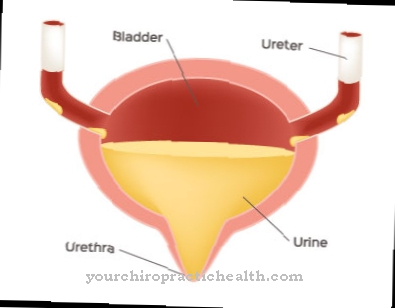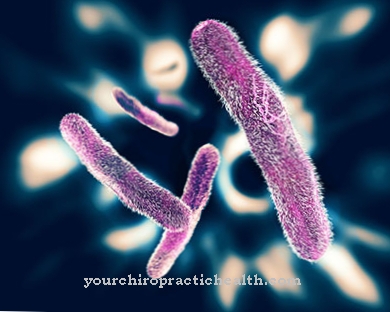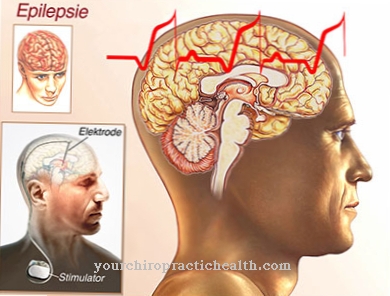John C. P. Williams (born 1922), a heart specialist from New Zealand, and the first German professor of pediatric cardiology, Alois Beuren (1919-1984), got the one named after them in the early 1960s Williams-Beuren Syndrome described as the first physician. The WBS is a genetic defect that has a significant impact on the internal organs, especially the heart, and the physical appearance of those affected. A malfunction of social behavior is also characteristic.
What is Williams-Beuren Syndrome?
How many children with that Williams-Beuren Syndrome come into the world has not yet been conclusively researched. The disease, which affects both girls and boys, or men and women, is rare. According to preliminary estimates, the probability of having the WBS in newborns is 1: 7,000 to 1: 50,000.
causes
The disease is caused by the absence (“deletion”) of a group of genes on chromosome 7, each group consisting of 23 or more units. The important structural protein elastin is affected by this deletion in almost all cases. Among other things, elastin is essential for the elasticity and strength of blood vessels.
Chromosome 7 contains 1,000 to 1,500 genes. The root cause of WBS is a corresponding undesirable development in the sperm or egg cell. The WBS arises from the involvement of such an incorrectly developed germ cell in fertilization.
Symptoms, ailments & signs
The symptoms of WBS are diverse and occur in different combinations in those affected. WBS students often have small heads with raised lips, hypoplastic “mouse teeth” and “bunny noses”, cushion-like upper eyelid regions and other rounded facial areas.
These "Funny Face" appearances created in connection with the WBS today only rarely used terms such as "goblin faces" or "elf children". In addition to weak muscle tension, short stature, blue iris, ametropia as well as toe and finger misalignments, impairments of internal organs are also typical for WBS. These include heart defects, narrowing of the blood vessels caused by an elastin deficiency, high blood pressure, kidney and lung problems.
Extended neck areas, a narrowed chest and sloping shoulders are also typical. WBS sufferers generally have a below-average intelligence. In return, however, they often have island talents (excellent memory, perfect pitch). The American Gloria Lenhoff, for example, became famous as a lyric soprano with a repertoire of 2,000 arias in 30 languages.
The gentle, peaceful, often helpful and empathetic WB students are extremely talkative, curious and sociable to the point of lack of distance. Their language skills and friendly curiosity make them appear intelligent at first, even though they have low IQ and do not know the meaning of many of the terms they use. This conspicuousness is called "Cocktail Party Manner".
But WBSpeople are also prone to depression, phobias and panic attacks. A special feature is the low reaction of those affected by WBS to situations given by angry people. Confrontations with extreme situations without people, such as volcanic eruptions or burning buildings, on the other hand, cause panic in those affected by WBS.
The trigger for this difference in intensity of non-social and social anxiety in those with WBS compared to those not affected by WBS is due to a change in the brain region known as the amygdala.
Diagnosis & course of disease
The Williams-Beuren syndrome, which is caused by gene loss, can be diagnosed early on using a chromosome analysis called "FISH test" (fluorescence in situ hybridization test). In this rapid cytogenetic test, a special dye associated with a blood sample only marks complete chromosomes.
In the event of gene loss, non-staining indicates the WBS. The test can also be performed prenatally. Because of the risk factors associated with the test for the unborn child when the amniotic fluid is taken, it is not used regularly in this phase.
Therefore, WBS often goes undetected for a long time in infants and toddlers. Especially since the Apgar test, which is often used in newborns, is not designed for the rare and largely unknown WBS. Usually, WBS is only noticed late because of certain behavioral problems. A laboratory analysis of the blood for the presence of hypercalcemia (excess of calcium) also enables evidence of a possible WBS.
Complications
The typical malformations make Williams-Beuren syndrome a very complicated disease. Growth retardation already occurs during pregnancy. After the birth, poor posture, neurological deficits and other complications occur as a result of the low muscle tension.
A typical secondary disease is so-called clinodactyly, in which the little fingers are bent to the side. In addition, misalignments of the toes can occur, which cause the affected children to walk unsteadily and posture. In the area of the internal organs, cardiac arrhythmias, high blood pressure and palpitations can occur.
If the disease is severe, the aortic constriction leads to heart failure. People with WBS are also at increased risk of kidney malformations. A disturbed kidney can lead to various complaints and sometimes even life-threatening complications. Children with Williams-Beuren syndrome also often suffer from swallowing difficulties, sleep disorders and developmental delays, all of which are associated with various physical and emotional complications.
Scoliosis, i.e. a curvature of the spine, can occur in old age. Surgical treatment of the malpositions is associated with the typical risks. Due to the often lifelong administration of medication, side effects, interactions and long-term effects cannot be ruled out.
When should you go to the doctor?
The "Williams-Beuren Syndrome" is a disease that manifests itself in the form of a developmental disorder with a heart defect. This is caused by a gene mutation on one of the two chromosomes number 7 and is therefore already present at birth. However, the frequency is around 1:20 000 affected people, which is why a prenatal examination rarely appears necessary.
There are a variety of symptoms that "WBS" patients can experience. This particularly includes the development of characteristic facial features. These include: a broad forehead, a flat bridge of the nose that ends in a spherical tip of the nose, protruding cheekbones, a large mouth, heavy eyes (upper eyelid edema), a short eyelid gap and a star-shaped drawing on the iris of the two Eyes.
Those affected more often show deficits in spatial vision, are sensitive to noise and can be prone to tooth decay. Furthermore, there can be serious malformations of the vessels. A doctor should be seen if symptoms are limiting for those affected.
People who are affected by the syndrome often have a special sense of rhythm and are therefore often musically gifted. Some affected children are also very lexical and learn to read before the regular children do. They also find it easy to communicate verbally and are very sociable. In spite of all this, "WBS" victims are dependent on the help of others for their entire lives.
Therapy & Treatment
After puberty, WBS sufferers often, but not necessarily, become weak in drive after a childhood characterized by hyperactivity. The WBS itself has no direct impact on the life expectancy of those affected. However, the impairment of organs caused by WBS can shorten life. A causal healing of the gene defect WBS is not possible. WBS therapy must therefore be limited to treating the symptoms.
Treating WBS-related symptoms can significantly improve quality of life. In this regard, treatments for the common heart defects and eye deformities come into consideration. Special diets can bring the hypercalcemia typical of WBS under control. Regular blood pressure checks are also indicated. Because of their numerous deficits, WBS sufferers are dependent on support in daily life for the rest of their lives.
In this context, intensive support measures (occupational therapy, music support) that begin as early as the toddler stage play an important role for the consistently developmentally delayed children with Williams-Beuren syndrome. Consistent upbringing for the observance of social rules for WBS students who like to approach other people without being asked is also part of life support.
Many WBS students can follow lessons at an integrative primary school, others are overwhelmed and need special special education instruction. WBS students almost always have a fulfilling life with their families and with the help of specialist offers.
You can find your medication here
➔ Medicines to calm down and strengthen nervesprevention
Due to the nature of this phenomenon as a spontaneous gene change, prevention of Williams-Beuren syndrome is not possible. Since the WBS is inherited with a 50 percent probability by parents in which one or both partners suffer from WBS, the ethically controversial approach of preventing WBS sufferers from having offspring is sometimes discussed.
Aftercare
Williams-Beuren syndrome is an incurable disease that is only treated symptomatically. Many of these symptoms can be treated by the sick themselves. To alleviate the symptoms, parents should enable the sick child to do gymnastics and occupational therapy. There, parents can learn many methods to treat the child from home and to significantly alleviate the symptoms.
In addition, the child should be adequately informed about their illness by the respective doctor. However, this should only happen when the child is of an appropriate age and maturity. It is also helpful to register the child with a self-help group. There it can learn how to deal with the disease in the long term.
They can also exchange opinions and experiences there with people who are equally ill and do not feel alone. It could also be helpful to give the child permanent psychological counseling. A psychologist can also teach the sick person how best to deal with the disease. The regular visits to the doctor should be observed.
Since secondary diseases can occur later in life as a result of the illness, visits to the doctor should be observed well into old age. Sufferers should choose a profession that can be practiced with the disease. The choice should also be discussed with the respective doctor.
You can do that yourself
Williams-Beuren syndrome is associated with various symptoms and ailments. Many of the symptoms can be treated by yourself.In the context of physiotherapy and occupational therapy, the legal guardians are given measures that the child can carry out at home to alleviate the symptoms. The more comprehensive this early intervention, the better the prognosis.
In addition, the child must be informed about their illness. The right time for this depends on the mental maturity of the child and is best chosen in consultation with the responsible doctor. The affected child can be informed about his or her illness through appropriate reading or discussions with other affected persons. The feature film "Gabrielle - (K) a completely normal love" portrays the life of an affected person in a documentary way and can also be used for educational purposes.
Regular visits to the doctor are also an important part of self-help. The medical check-ups have to be continued into old age, as further symptoms such as scoliosis can occur in the course of life. Various lifestyle changes are also necessary, such as sufficient rest and the choice of a job that can be carried out with the respective malformations and diseases. The necessary steps are discussed during a consultation with the specialist.



.jpg)

.jpg)





















